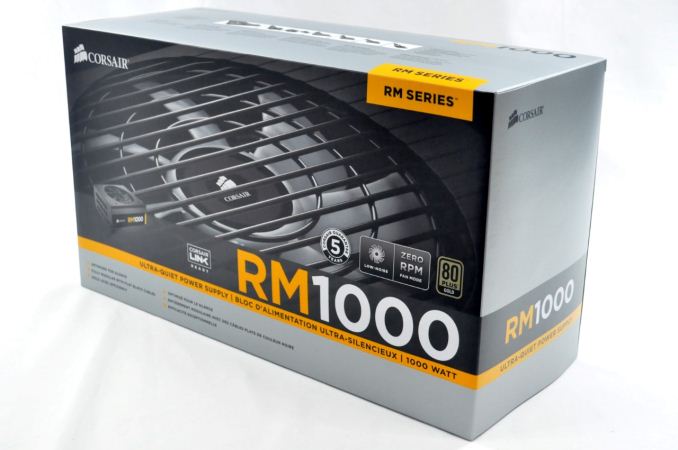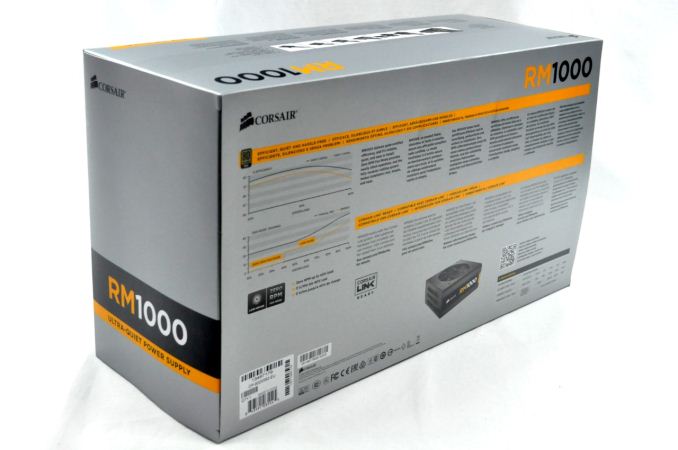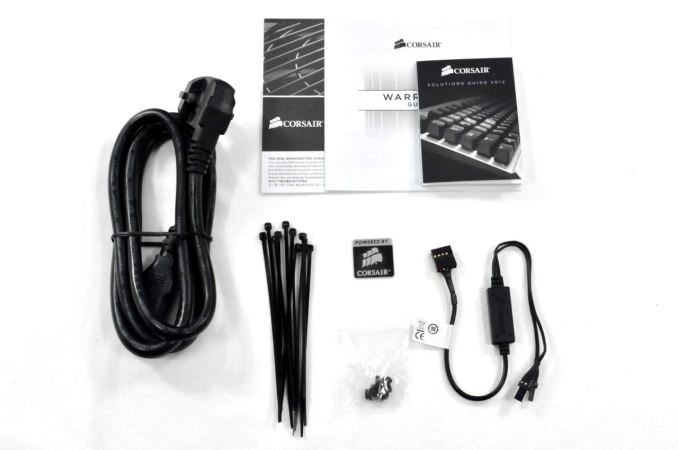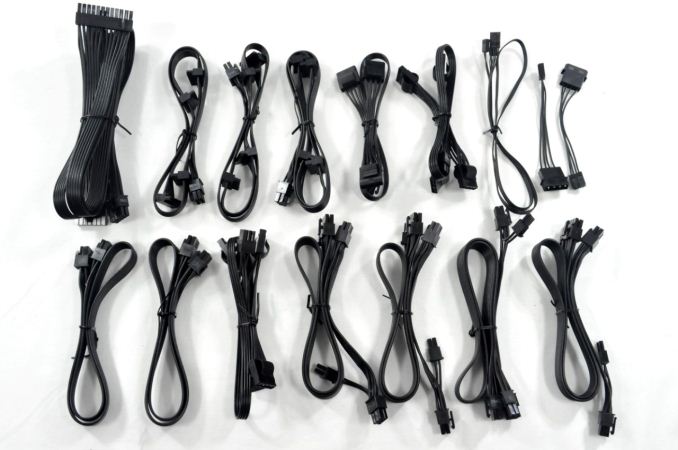Corsair RM1000 Power Supply Review
by E. Fylladitakis on April 24, 2014 6:00 AM EST- Posted in
- Cases/Cooling/PSUs
- Corsair
- PSUs
- RM Series

Introduction
Corsair has created a good reputation for their branded PSUs, and today they are among the most popular choices for gamers and enthusiasts. The first PSU from Corsair to find its way into our new testing lab is the RM1000, an 80 Plus Gold Certified unit with a rated output of 1000W at 40°C ambient. Given the rated power output and retail price of $169.99 after rebate, the RM1000 is understandably targeted at advanced users and gamers, and very few PCs require so much power. The target audience can be quite demanding, however, and a simple 80 Plus Gold certification is not enough to entice such users, so let's see what else Corsair has up their sleeves.
The RM series PSUs are optimized for silence and there are currently six models, ranging from 450W to 1000W. That makes the RM1000 the most powerful model of the series but it also is significantly different from the less powerful models as well. In fact, it's almost entirely different. The 750W and the 850W models come from a different ODM, as they are based off of Chicony Electronics designs, while Channel Well Technologies (CWT) supplies the other four models. As such, the RM1000 and the RM450/RM550/RM650 are all based on a CWT design, yet the RM1000 we're looking at is based on a different platform than that of the lower wattage models.
Corsair has had many CWT derived designs in the past and most of them were very popular among advanced users. However, times have changed and there is stiff competition in the market right now, especially in this particular segment, as every single manufacturer apparently wants a high performance 1000W model as their halo product, and the market has been virtually flooded with such PSUs. Not surprisingly, it's no longer possible to compete at the top of the market by simply offering a "high performance" PSU. Let's have a thorough look at the RM1000 and see what it can offer to consumers and where it falls short.
Packaging and bundle
We received the Corsair RM1000 inside a large, interestingly designed cardboard box. Most of the box is grey with yellow colored accents, the series' trademark. The front and sides of the box are relatively tidy, with badges and summarized descriptions of the most important features. The rear of the box offers a wealth of information regarding the performance of the power supply, summarized in charts and a table rather than tons of marketing text.
The Corsair RM1000 bundle is adequate, but it could have been better for a unit of this class. Alongside the power cord, manual and screws, Corsair also supplies a few cable ties, a case badge with the company's logo, a Corsair Link interface cable, and an advertising leaflet.
As this is a high output, fully modular unit, numerous cables are supplied alongside the PSU. All of the cables, including the ATX connector, are black ribbon cables without sleeving. Some will say they look significantly better than sleeved color-coded wires and require less space, though that's a matter of personal preference. while it looks like Corsair chose not to include a bag for the extra cables, the body of the unit itself comes wrapped inside a pouch for protection during shipping, and this pouch can be used to store the cables later on.














55 Comments
View All Comments
ssj3gohan - Monday, April 28, 2014 - link
Can I give some constructive criticism?The review is missing some parts that would be very useful:
- The teardown is extremely short and basically useless. All the information we get from it is that it's made by CWT. There is a lot more to see that is relevant, like the topology (it's obviously LLC resonant, otherwise the heatsinks for the active devices could never be that small even for a lower powered unit. They dissipate so little because they are switched at zero voltage and current all the time (ZVCS) instead of only half of the time (pseudoresonant) or never (traditional push-pull). Switching losses are the biggest issue in high current PSUs. Another important thing to note is the make of the controller chip(s), as this usually gives a good idea of the modern-ness of the design (LLC resonant has been around for 20 years, but only recently have they really started to do propagation time compensation and such awesomeness). It's also important to note that for instance on this unit, the non-important cap (input filter cap) is from a good brand and the caps that actually matter (high ripple current, high stress in general) are B or C grade. CapXon is not something I would trust handling a couple tens of amps of ripple current for 5 years. Lots of reviewers get fooled by the big shiny cap on the input having the good markings, but this misses the point of cap quality inspection. There's more that should be in the teardown, but for that I'd just recommend aping Jonnyguru, X-bit labs or such people.
- On the hot *and* cold tests (as well as crossload), at least include a table of the actually used loads and results in numbers, as well as your total (un)calibrated error - depending on whether all your instruments are calibrated or not.
- Don't fucking interpolate to get nice graphs! This is a deathly sin in data processing. It causes all kinds of crazy things, like implying that the slope of the efficiency graphs is a certain value at the edges (while it probably is something completely else) and causing the weird ripples in the efficiency curve you see. I'd bet money that that ripply stuff is just measurement error. In fact, the entire graphs are a big departure from both the 80 Plus test report and other review sites, so even if this is not actually an error on your part, we need to be able to properly compare this (with table values) to be sure. Even just the sentence 'this PSU was tested on 230VAC input while most other sites test at 115VAC input; this may inflate efficiency numbers' would greatly improve the review.
- This leads to the next point: interpret the data for us, give us a well-researched explanation for weirdness. Why do the SPL numbers look the way they look? Did you have a tachometer? Did the sound have a broad spectrum or was it whiny?
- Also: another case of interpolation causing weird graphs is the heatsink temperature graph. Cut that graph in the middle, and annotate it on the left with 'fan off' and on the right with 'fan on'. Don't try to connect the two separate domains, it is meaningless and just causes weird bumps in the graph that are not there!
- In the conclusion, don't just give a conclusion on this unit in a vacuum. You're a review site! You are supposed to know the market, know the competition. Tell us how the unit performs compared to the competition and how well it is priced. THEN give us a recommendation. Take into account the industry standing of the brand and previous PSUs. As it stands, the conclusion is not satisfactory.
I'm not trying to be harsh, but Anandtech has a good reputation and there are too few good PSU reviewers around on the internet. You're one of only 3 semi-fulltime PSU reviewers with a master's and/or PhD in the right area, so I have high hopes for the future. I already had high hopes when you were introduced for the first time, but the reviews so far have been passable instead of great. This needs to be fixed.
Michal Daniel - Wednesday, April 30, 2014 - link
Makes for a splendid hackintosh. Typing this on it.http://www.proofsheet.com/macbeast/all.html
amazingrugs - Friday, May 9, 2014 - link
I've been out of the building game for quite a while. I think the last system I built had a Radeon 9500, when AGP was all the rage! What kind of system does it take to push a PSU like this?alostpacket - Thursday, May 15, 2014 - link
You guys should never post after-rebate prices, you are doing their marketing for them.burningisis - Monday, November 16, 2015 - link
I think another use for a high wattage PSU like this other than mining or those using autocad... future proofing a machine. I know I've replaced enough PSUs on my machines as I upgrade GPUs or upgrade the number of drives I use or if I decide to push overclocking. I know some users are going smaller but there are users still out there demanding larger PSUs, running 3+ GPUs, running multiple processors on an enthusiast system. It may be a small subset of users, but there is a demand out there for these, and this looks like a very nice PSU to future proof a build as well